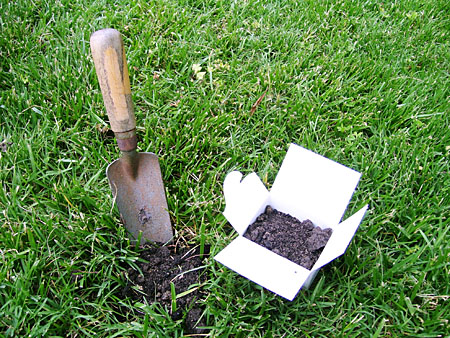Along with water and air, soil is one of the three essential elements that make life on Earth possible. It is the medium in which all plant life grows; it is a means of water storage, supply and purification; it is an important part of the nitrogen cycle that modifies the atmosphere; it is a recycling system for nutrients and organic wastes; and it is a habitat for countless micro-organisms and chemical compounds essential to the creation and growth of our food supply.
Soil is made up of three main components that can exist in various proportions in any particular landscape: minerals that come from the rock below the soil, organic matter which is the remains of plants and animals that use the soil, and the living organisms that reside within the soil.
Soil Contamination
Soil contamination, or soil pollution, occurs when man-made chemicals or behaviors alter the natural balance of the soil environment. This contamination can come from various sources: industrial activity that produces hazardous chemical byproducts; waste from mining operations such as coal ash and tailings; the application of pesticides, herbicides and fertilizers in large scale agricultural concerns; runoff from livestock manure; the illegal dumping of oil and other petroleum byproducts; accidental spills of solvents and other inorganic compounds; etc.
Soil at a residential property can also become contaminated when home septic systems and leach fields breach their boundaries or when underground storage cisterns burst. However, the three most widespread pollutants in residential soils – both urban and rural – are lead, arsenic and cadmium. These elements, which were used widely in paints and construction materials for many years, are “heavy metals” that do not readily break down or decompose. As such, they continue to be found in the spaces between soil particles.
Why is Soil Contamination Hazardous?
Contaminated soil is dangerous to both humans and animals. Lead from paint residue that chips and falls to the ground as time and the elements wear away a home’s exterior, arsenic that was used as a wood preservative in houses and exterior structures, or from pesticides and fertilizers, and cadmium that has entered the environment from the burning of fossil fuels and municipal wastes, or from the smelting of zinc, lead, and copper, are all poisons that can cause health problems ranging from headaches and rashes to cancers, neural and reproductive disorders, birth defects and even death, when ingested or inhaled in sufficient quantities.
Also, when these chemicals invade the drinking water supply, or contaminate fruits and vegetables headed for human consumption, they can continue to cause serious damage to the body’s tissues and organs even when the contact with them is insidious and more indirect.
How to Tell if Soil at a Property is Contaminated
It is not always easy to determine whether soil at a property is contaminated. Sometimes, there may be visible or other clues that suggest contamination, for example: paint chips around the exterior of a house if it is known that the paint contained lead; areas of unnatural discoloration in the soil; strong odors emanating from the ground; or places where vegetation fails to thrive when other disincentives for growth have been ruled out.
Sometimes, a little detective work is necessary. Was the land adjacent to the residential property ever used for agriculture, livestock breeding, heavy industry, mining or waste disposal? Were there ever wooden structures on the property prior to the late 1970s, before lead and arsenic were discontinued in paint and construction materials? However, in the end, the only sure way to tell if soil is contaminated is to have samples tested in the laboratory.
What Precautions Should be Taken with Soil that is, or is Suspected to be, Contaminated?
Once it is known that residential soil is contaminated, or even suspected of contamination, the following precautions are advisable:
- Partition off the hazardous areas and minimize any exposure, especially to children and pets
- When mowing grass, or working in or near a hazardous area, wear protective clothing and equipment, including a dust mask or respirator, and protective eyewear
- Make sure that home gardens are located away from hazardous areas and always thoroughly wash all produce before consuming
Remediating Contaminated Soil
Soil remediation includes various strategies that are used to purity or revitalize contaminated soil. Its goal is to either correct damage that has been done by removing the contaminated area or to make it possible for contaminated land to be restored to a state where it can be considered safe for human habitation.
Because complete remediation of contaminated soil can be very expensive, it is not always an option for the individual homeowner. In situations where the contamination is widespread, local, state, or even the federal government must step in and spearhead remediation and reclamation efforts.
Soil remediation techniques include the following:
- Excavation and Dredging – the contaminated soil is removed and transferred to a landfill for disposal. New soil is distributed to replace the old.
- Soil Blending – contaminated soil is mixed with fresh soil to lower the concentration of contaminants to an acceptable level.
- Soil Treating – contaminated soil can be treated with aeration, heat, water or chemicals that change hazardous substances into chemicals that will biodegrade over time.
- Bioremediation – specific plants or fungi are used to naturally break down hazardous materials.
- Capping and Paving Over – problem areas can be covered either with more than a foot of new topsoil, or completely paved over. This is considered only a temporary solution that may only inhibit the contamination from spreading further until a more long-term solution is applied.
